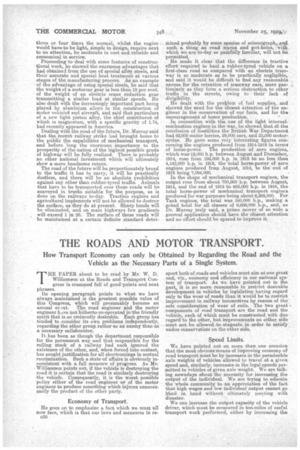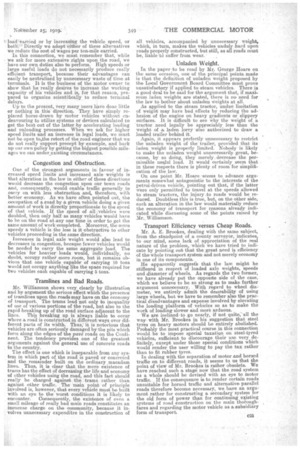THE ROADS AND MOTOR TRANSPORT.
Page 22

Page 23

If you've noticed an error in this article please click here to report it so we can fix it.
How Transport Economy can only be Obtained by Regarding the Road and the Vehicle as the Necessary Parts of a Single System.
THE PAPER about to be read by Mr. W. D. Williamson at the Roads and Transport Con.gress is crammed full of good ;points and neat phrases.
Its opening paragraph points to what we have always maintained is the greatest possible value of this Congress, which will presumably become an annual ev:oit. The road engineer and the motor engineer h.ive not hitherto co-operated in the friendly spirit that is so eminently desirable. Each group has tended to consider its own probleras independently, regarding the other group rather as an enemy than as a necessary collaborator.
It has been as though the department responsible for the permanent way and that responsible for the rolling stock of a railway had each ignored the existence of the other, and, when forced into contact, has sought justification for all shortcomings in mutual recrimination. Such a state of affairs is obviously inconsistent with a full measure of progress. As Mr. Williamson points out, if the vehicle is destroying the road it is certain that the road is similarly destroying the vehicle. Consequently, it is the worst possible policy either of the road engineer or of the motor engineer to produce something which injures unnecessarily the product of the other party.
Economy of Transport.
He goes on to emphasize a fact which we must all now face, which is that our laws and measures in ree30 spect both of roads and vehicles must aim at one great end, viz., economy and efficiency in our national system of transport. As we have pointed out in the past, it is no more reasonable to restrict desirable development in vehicles by legislation having regard only to the wear of roads than it would be torestrict improvement in railway locomotives by reason of the sole consideration of wear of rails. The two great components of road 'transport are the road and the vehicle, each of which must be constructed with due regard to the other, but improvements on either side must not be allowed to stagnate in order to satisfy undue conservatism on the other side.
Speed Limits.
We have pointed out on more than-, one occasion that the most obvious`means of improving economy of road transport must be by increases in the permissible axle weights of vehicles allowed to travel at a given speed and, similarly., increases in the legal speeds permitted to vehicles of given axle weight. We are talk-. ing nowadays about the necessity for increasing the output of the individual. We are trying to educate the whole community to an appreciation of the fact that high wages and low individual output cannot go hand in, hand-without ultimately meeting with disaster.
We can increase the output capacity of the vehicle driver, which must be measured in ton-railes of useful transport work performed, either by increasing the
1oatIgearrierl or by increasing the vehicle speed, or both P Directly we adopt either of these alternatives we rediiee the cost of wages per ton-mile carried. In this connection, we must remember that, while we ask for more extensive rights upon the road, we have our own duties also to perform. High speeds or large useful leads do not necessarily produce really efficient transport, because their advantages can easily be neutralised by unnecessary waste of time at terminals. It is the business of the motor owner to show that he really desires to increase the working capacity of his vehicles and is for that reason, prepared to organize scientifically to reduce terminal delays.
Up to the present, very many users have done little or nothing in this direction. They have simply replaced horse-drawn •by motor vehicles without endeavouring to utilize systems or devices calculated to get the best out of the latter by aeeelerating loading and unloading processes. When we ask for higher speed limits 'and an increase in legal loads, we must not be open toethe retort of the road engineer that we do not really support preeept by example, and back up our own policy by getting the biggest possible mileages we can under existing circumstances.
Congestion and Obstruction.
One of the strongest arguments in favour of increased speed limits and increased axle weights is that alteration in the law in either of these directions would decrease the congestion upon our town roads and, consequently, would enable traffic generally to carry on with less obstruction and„ therefore, with better economy. As we have often pointed out, the occupation of a goad by a given vehicle doing a given amount of work is directly proportionate to the speed of that vehicle. If the speed of all .vehicles were doubled, then only half as many vehicles would have to be on the road at any one time in order to get the same amount of work completed. Moreover, the more speedy a vehicle is the lees is it obstructive to other vehicles proceeding in the same direction.
Increases in legal axle weight would also lead to decreases in congestion, because fewer vehicles would be needed to carry the same aggregate load. The -vehicles for heavier loads would, individually, no doubt, 'occupy rather more room, but it remains obvious that one vehicle capable of carrying 10 tons 'would not occupy anything like the space required for two vehicles each capable of carrying 5 tons.
Tramlines and Bad Roads.
Mr. Williamson shows very clearly by illustration and by argument the serious effect which the presence of tramlines upon the roads may have on the economy of transport. The trams lead not only to inequality of use of various portions of the road, but also to the rapid breaking up of the road surface adjacent to the lines. This breaking up is always liable to occur where a road is constructed in different ways over different parts of its width. Thus; it is notorious that vehicles are often seriously damaged by the pits which form along the edges of the pave roads on the Continent. The tendency provides one of the greatest arguments against the general use of concrete roads in the country. The effect is one which is inseparable from any ayetern in which part of the road is paved or concreted and the remainder built on the ordinary macadam lines. Thus, it is clear that the mere eiristence of trams has the effect of decreasing the life and economy of other vehicles using the road, and this fact should really be charged against the trams rather than against other traffic. The main point of principle involved is, however, that every vehicle must be built with an eye to the worst conditions it is likely to encounter.' Consequently, the existence of even a small mileage of really bad main roads constitutes an immense charge on the community, because it involves unnecessary expenditre in the construction of all vehicles, accompanied by unnecessary weight, which, in turn, makes the vehicles unduly hard upon roads properly cohstructed, but still, as all roads must be, liable rtai suffer from wear.
Unladen Weight.
In the paper to be read by Mr. George Hoare on the same oecitsion, one of theprincipal points made is that the definition of unladen weight proposed by the Local Government Board Committee must prove unsatisfactory if applied to steam vehicles. There is a good deal to be said for the argument that, if maximum laden weights are stated, there is no need for the law to bother about unladen Weights at all.
As applied to the steam tractor, undue limitation of weigh-t may have bad effects by reducing the adhesion of the engine on heavy gradients or slippery surfaces. It is difficult to see why the weight of a tractor need legally be appreciably less-than the weight of a laden lorry also authorized to draw a loaded trailer behind it.
Again, it appears perfectly unnecessary to restrict the unladen weight of the trailer, provided that its laden weight is properly limited. Nobody is likely to make the unladen weight unnecessarily great, because, by so doing, they merely, decrease the permissible useful load. It would certainly seem that in these respects there, is plenty of room for simplification of the law.
On. one point Mr. Hoare • seems to advance arguments eomewhat antagonistic to the interests of the petrol-driven vehicle, pointing out that, if the latter Were only permitted to travel at the speeds allowed to steamtractors,, the injury .to roads would be reduced. Doubtless this is true, but, on the other side, such an alteration in the law would materially reduce the economy of transport for reasons already indicated while discussing some of the points raised by Mr. Williamson.
Transport Efficiency versus Cheap Roads.
Mr. A. E. Brookes, dealing with the same subject, from the standpoint of a county surveyor, indicates, to our mind, some lack of appreciation of the real nature of the problem, which we have tried to indicate by pointing out that the great need is efficiency of the whole transport system and not merely economy in one of its components. He apparently suggests that the lam might be stiffened in respect of loaded axle weights, speeds and diameter of wheels. As regards the two former, we have already put the opposite side of the ease, which we believe to be so strong as to make further argument unnecessary. With regard to wheel dia.meter, we entirely admit the dew-ability of using large wheels, but we have to remember also the practical disadvantages and expense involved by elevating the loading platform of vehicles so as to make the work of leading slower, and more arduous.
We are inclinedto go nearly, if not quite, all the way with Mr. Brookes in his suggestion that steel tyres on heavy motors should be entirely abolished. Probably the most practical course in this connection would be to impose special taxation on steel-tyred vehicles, sufficient to discourage their use very definitely, except under those special conditions which would render the user willing to pay the tax rather than to fit rubber tyres.
In dealing with the separation of motor and horsed traffic on to different roads, it seems to us that the point of view of Mr. Brookes is rather obsolete_ We have reached such a stage now that the road system as a whole should be devised with an eye to motor traffic. If the consequence is to render certain roads unsuitable for horsed traffic and alternativeparallel roads therefore become necessary, we have an ar naent rather for constructing a secondary system toy the old form of power than for continuing 'existing systems of road construction on the main thoroughfares and regarding the motor vehicle as a subsidiary form of transport.








































